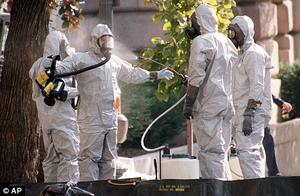U.S. not ready for clean up effort after a bioterror attack
The small 2001 anthrax attack in the United States cost hundreds of millions of dollars in decontamination costs, and some of the facilities attacked could not be reopened for more than two years; a large-scale biological release in an American city, though, could potentially result in hundreds of thousands of illnesses and deaths and could cost trillions of dollars to clean up

Hosing down a worker involved in anthrax cleanup // Source: dailymail.co.uk
Following the 2001 anthrax attacks, the government and private sector undertook the task of cleaning up anthrax-contaminated facilities — a job that had never before been attempted on that scale. Decontaminating congressional office buildings, postal facilities, and media buildings cost hundreds of millions of dollars, and some of the facilities could not be reopened for more than two years.
Nine years later, what progress has been made in policy and practice that would make decontamination easier in the event of another attack? A recent assessment, sponsored by the Commission on the Prevention of Weapons of Mass Destruction Proliferation and Terrorism and appearing in the journal Biosecurity and Bioterrorism, found that the process of environmental decontamination would still be very difficult and costly and that the lines of responsibility at the federal level are still unclear.
The 2001 anthrax attack is considered to be a small attack, because relatively few facilities were involved and anthrax contamination was limited to indoor environments. A large-scale biological release, though, could potentially result in hundreds of thousands of illnesses and deaths and could cost trillions of dollars to clean up. An attack on a U.S. city could contaminate both indoor and outdoor areas, including buildings, street, parks, and vehicles.
Researchers from the Center for Biosecurity of the University of Pittsburgh Medical Center looked at current decontamination policy and technical practices at the federal level to determine what gaps exist that might hamper response to a future large-scale attack with a biological agent. The government agencies with primary responsibility for decontamination are the Environmental Protection Agency (EPA), the Department of Homeland Security (DHS), and the Department of Defense (DoD). Federal roles and responsibilities for decontamination research and response are not clearly spelled out, overlap, and are often underfunded..
The article also describes some of the technical and scientific issues that remain unresolved: After an anthrax release, what is the risk of secondary aerosolization? What is the federal standard for decontamination — or, how clean is clean? How clean is safe?
The authors note that there are too few personnel trained in decontamination among all of the agencies and including private contractors. In the event of an attack, private building owners and government agencies would likely be calling on the same limited pool of experts and contractors to help with remediation.
Among the recommendations the authors propose:
- DHS should clarify federal roles and responsibilities
- Congress should increase funding for decontamination research
- In addition to research, additional investment in personnel is needed
—Read more in Crystal Franco and Nidhi Bouri, “Environmental Decontamination Following a Large-Scale Bioterrorism Attack: Federal Progress and Remaining Gaps” Biosecurity and Bioterrorism, forthcoming (June 2010)
